Many accomplished businesses emphasize the significance of having well-defined SMART goals to avoid stagnation or aimlessness. Moreover, navigating the path toward achieving your goals can only be challenging with a clear roadmap. So employing SMART goals can be an invaluable strategy for attaining success.
In this article, we will explore the basic concept of SMART goals, highlighting their significance and demonstrating how they can effectively aid you in accomplishing your objectives.
Part 1. What Are SMART Goals?
When setting goals, SMART is a handy acronym to remember. SMART stands for Specific, Measurable, Achievable, Relevant, and Time-bound. These are essential qualities that make goal-setting effective. SMART goals examples are like a tool that helps you keep track of your progress and stay accountable while working towards what you want. They are a valuable way to evaluate and achieve your objectives.
By setting SMART goals, you can determine what actions you need to take to reach your desired outcome. Let's say you want to get better at typing. When you use the SMART method to think about your goal, you might realize it could be more specific. To make it more specific, you can replace your goal with "increase my typing speed." This way, you have a clear target that you can measure and keep track of.
Part 2. What is SMART Goal Format?
The SMART goal format is a framework that helps you create well-defined and achievable objectives. After all, SMART is an acronym for Specific, Measurable, Achievable, Realistic, and Time-bound. Each element of the acronym emphasizes essential aspects of goal-setting to ensure clarity, measurability, feasibility, and timely completion. Let's explore each component in detail:
1. Specific
Setting specific goals is essential to provide clear direction and focus. Rather than formulating broad objectives, it is vital to narrow down your goals to a particular outcome. By being specific, you can clearly define what are SMART goals and align your efforts accordingly.
2. Measurable
Measurability ensures that your goals have tangible metrics or criteria by which you can evaluate progress and success. Including measurable elements in your goals lets you track your performance and determine if you are on track or need adjustments.
3. Achievable
Goals should be challenging yet attainable within the given resources and constraints. Setting achievable goals means ensuring they are within your reach and realistic. It requires evaluating your capabilities, available resources, and potential obstacles.
4. Realistic
Realistic goals consider various factors such as available resources, time constraints, and practical considerations. They are closely related to achievable goals but focus on the overall feasibility and reasonableness of the objective.
5. Time-Bound
Time-bound SMART goals have a specific timeframe or deadline attached to them. This element adds a sense of urgency and helps prevent procrastination or indefinite delays. By setting a clear timeline, you create a sense of accountability and prioritize your actions accordingly.
Part 3. Why Are SMART Goals Important?
Many ways describe the importance of these goals in our daily lives. From focus to better decision-making, SMART goals help us achieve success in every field. Now, let's explore these benefits and learn how they can positively impact individuals and businesses:
- Enhanced Clarity and Focus: They provide a clear and specific target, enabling individuals and businesses to understand what they aim to achieve precisely. This clarity helps direct efforts and resources toward the desired outcome, minimizing distractions and increasing focus.
- Increased Motivation: The SMART framework offers a sense of purpose and motivation by breaking down goals into actionable steps. With measurable milestones and a realistic timeline, individuals can track their progress and witness tangible results.
- Improved Time Management: By setting deadlines and incorporating time-bound elements, SMART goals promote effective time management. They create a sense of urgency, preventing procrastination and allowing individuals and businesses to allocate their time wisely.
- Better Decision-Making: These goals enable individuals and businesses to make informed decisions. You align actions and strategies with the desired outcome. Moreover, with a clear understanding of goals' specific, measurable, and realistic aspects.
- Heightened Accountability: SMART goals establish a framework for accountability. With specific metrics to measure progress, individuals and businesses can hold themselves accountable for their actions, regularly assess their performance, and make necessary adjustments to stay on track.
Part 4. How to Set SMART Goals?
Setting SMART goals is a proven method for achieving personal and professional success. By following this framework, individuals can create SMART goals examples. Establishing a systematic approach is essential to set these goals effectively. Below, explore some critical methods to help you develop these goals comprehensively.
Step 1: Define Specific Goals
The first step to setting SMART Goals is to define specific goals. Specificity is crucial in setting SMART goals as it provides clarity and direction. Clearly articulate what you want to achieve and ensure your goals are well-defined. For example, instead of developing a complex goal like "exercise more," specify it as "exercise for at least 30 minutes, five times a week."
Defining your goals precisely helps you create a clear target to strive for and eliminate ambiguity. This will lead to achieving goals right and without any barriers.
Step 2: Establish Measurable Criteria
Adjusting measurable criteria enables you to track progress and determine when you have achieved your goals. Ensure that your goals have quantifiable elements that can be objectively measured. For instance, if your goal is to increase sales, you can set a measurable criterion, such as "increase sales revenue by 10% within six months."
Establishing measurable criteria can assist you in monitoring your progress, identifying any necessary adjustments, and celebrating milestones along the way.
Step 3: Evaluate Goal Achievability
When setting SMART goals, it is vital to assess their achievability. Consider the resources, skills, and time available to determine if the goals are realistic and attainable. While it is essential to aim high, setting too challenging or unrealistic goals can lead to discouragement and a lack of motivation. Ensure that your goals are within reach and aligned with your capabilities.
In addition, they should still push you to grow and stretch your abilities. This step helps you strike the right balance between ambition and feasibility.
Step 4: Create a Planner and Keep Tracking
After deciding the SMART goals that you want to achieve, it is crucial to establish a planner that will serve as a central hub for tracking progress. UPDF tool is a great tool to create customized planners that align with individual preferences and requirements as it provides daily planner template and goal setting template for you to customize. With UPDF, you can customize and design a goal-oriented planner using various editing and formatting features.
Windows • macOS • iOS • Android 100% secure

Additionally, UPDF's editing capabilities allow you to personalize your PDF daily planner template further by adding specific sections or texts tailored to your goals. This step sets the foundation for practical goal-setting by ensuring clarity and accountability.
Steps to Help You Customize SMART Goals Planner Conveniently
Now that you know how UPDF helps you track goals and customize the planner, let's head to the steps. These steps can help you save time and achieve the results in a better way:
1: Open UPDF and Import Related Template
Locate the UPDF tool on your device, and double-click to open it. Now hit the “Open File” option, and import the desired planner template file in UPDF. In addition, you can also drag and drop the file directly into the tool.
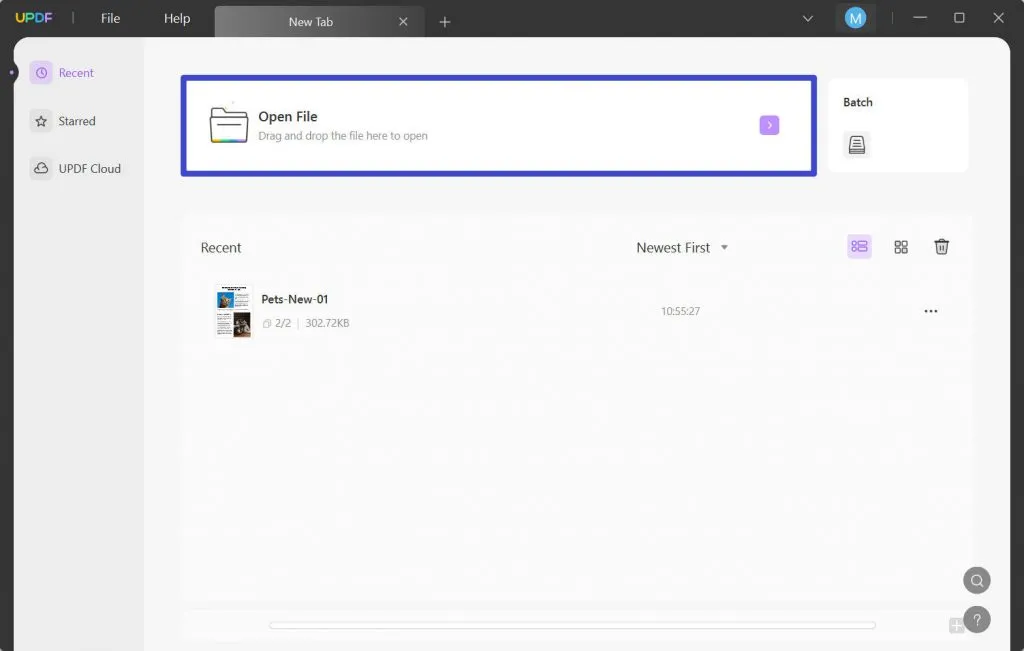
2: Start Editing to Customize It
As you have imported the template, click anywhere on the required fields and fill them in based on your goals. In addition, head to the left-side toolbar and select the "Edit PDF" option. Then, press "Text" in the top bar to add text to the planner or remove it.

3: Save Settings and Print the Template
In addition to the previous step, UPDF allows you to customize the text alignment, size, color, and font. Proceeding further, you will see the "File" tab in the upper left corner. Tap it and choose “Print” from the menu. Optimize printing properties if needed and finally hit the "Print" button to print the planner for use.
Windows • macOS • iOS • Android 100% secure
Part 5. 5 Best SMART Goal Generators
Embarking on a journey of personal growth and accomplishment requires a well-defined roadmap, and a SMART goal generator serves as an invaluable tool. These innovative tools empower individuals to set related objectives, capitalizing on their full potential. These tools include:
1. StudyCorgi

StudyCorgi invites you to explore the benefits of free online tools specifically designed to assist you in creating SMART goals. This tool contains three simple steps you can utilize to their fullest potential. Once you have gathered all the essential information required for your goal, effortlessly enter it into the appropriate fields of the SMART goal generator.
Customize your goal template by choosing from various visually appealing styles. After finalizing your SMART goal using this tool, you can conveniently download the file in a suitable format. This ensures you have a digital copy of your goal readily available for future reference or sharing with others.
2. IvyPanda
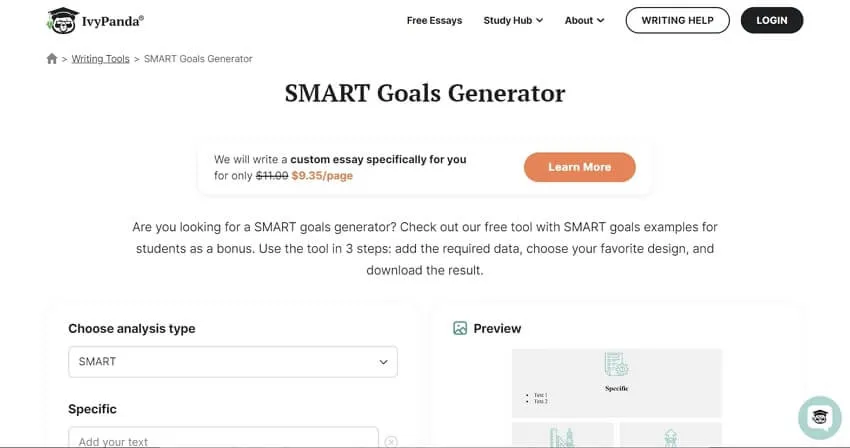
The IvyPanda SMART goal generator is a powerful tool designed to equip individuals with the necessary skills. This tool assists users to track their overall growth and progress, identify their strengths, and identify areas for improvement. Begin by inputting all the relevant details into the goal generator. This may include information such as your project objectives, target completion date, and specific actions required.
After entering the required information, you can select your preferred design template from a range of options provided by the SMART goal generator. When finalizing your goal details and design selection, the SMART goal generator will generate a customized report based on your inputs.
3. Napier
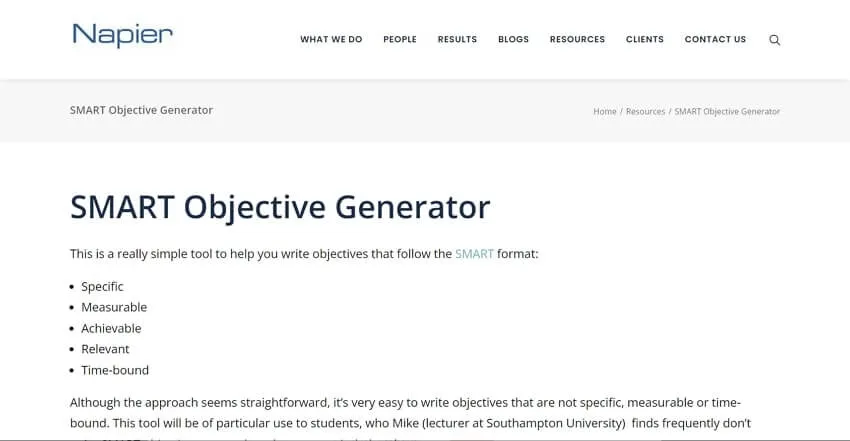
Napier is a user-friendly tool designed to assist you in crafting objectives that adhere to the SMART format. While the SMART approach may appear simple, it is common to unintentionally overlook specificity, measurability, or time-bound parameters when writing objectives. This tool is especially valuable for students who observe a recurring tendency among them.
To generate your SMART objective, proceed by completing the form provided on the website. Fill in the required fields, and the tool will readily create the best SMART goal for you.
4. Lifetick
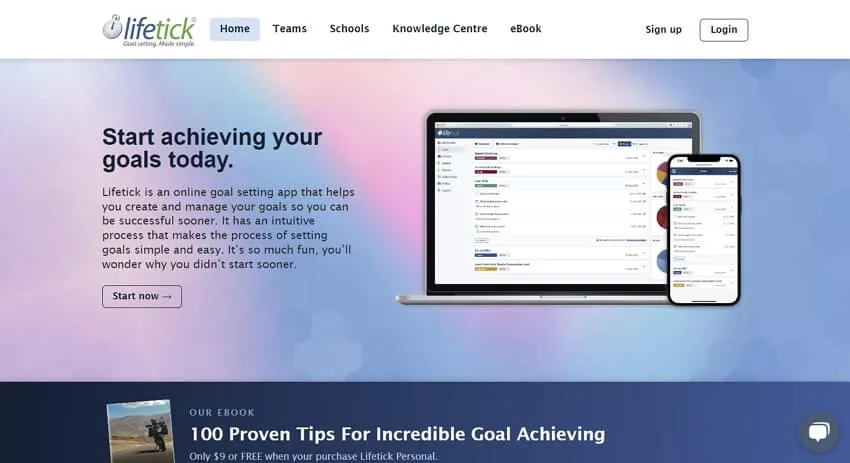
When utilizing the Lifetick tool for SMART goal setting, the initial task is determining your core values. This tool is important because it encourages you to contemplate how your SMART goals correspond with your core values. The developers of this app firmly believe that when your goals are in harmony with your core values, you enhance your likelihood of accomplishing them.
Furthermore, this tool offers additional features to support your success, such as a personal journal, habit builder and tracker, progress report charts, and task reminders.
5. Asana
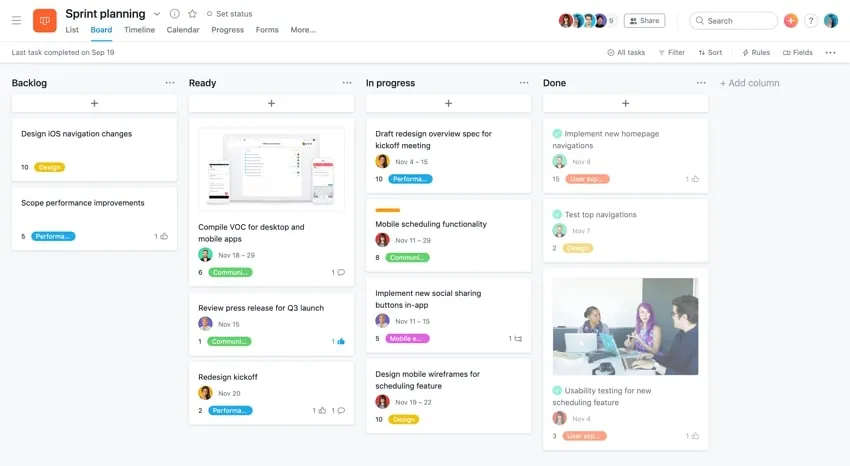
Asana, an efficient tool for SMART goal examples management, assists teams in sharing and achieving their objectives. With this application, you can conveniently oversee and track your goals while working with others. All the essential goal-setting and monitoring features are consolidated in a single platform.
To foster motivation among team members, a progress bar and a comprehensive status report are prominently showcased on the goal interface.
Part 6. 5 SMART Goals Examples for Work
Effective goal setting is crucial for driving success and alignment within a workplace. Here are five SMART goals examples for work that can help organizations optimize their goal-setting process:
1. Ensure Timely Arrival at Work
Punctuality is crucial for maintaining good work performance. By calculating the frequency of late arrivals, you can assess the extent of improvement required. This goal is highly attainable as it involves making small adjustments to your daily routine. Moreover, achieving this goal directly impacts your work productivity. The time frame for this SMART goal is one month, which is a reasonable duration.
2. Develop Proficiency in a Specific Skill
Focusing on a particular skill, such as learning Excel, provides a clear objective. Tracking your progress throughout your work can be achieved by constant monitoring. Acquiring a new skill through a course is time-efficient and doesn't require extensive prior knowledge. This goal aligns directly with your work responsibilities since you identify the skill you want to improve.
3. Reduce Overtime Hours to Improve Work-Life Balance
Achieving a healthy work-life balance is the specific aim of this goal. Tracking the number of overtime hours worked on a weekly basis throughout a month allows you to gauge your progress. Additionally, consider evaluating the impact of reducing overtime on your overall work performance. This goal is achievable while ensuring financial stability. However, it may require customization to suit the circumstances.
4. Improve Financial Stability Through Freelancing
This goal focuses on augmenting your finances and professional experience through freelance work. You can track your progress by recording the number of projects completed each week and the corresponding income generated. Freelance projects can be accomplished during spare time or on weekends, making them achievable alongside regular work commitments.
5. Enhance Communication and Teamwork
The specific goal is to make effective communication and teamwork in your workplace. You can measure progress by tracking the number of meetings organized, the level of colleague participation, and the duration of the meetings. Setting a goal of conducting half-hour meetings twice a week is realistic and attainable. Improving team-wide communication directly contributes to increased productivity.
Part 7. 5 SMART Goal Examples for Students
Organizing goals is essential for students to maximize their academic potential and personal growth. Students can focus their efforts and track their progress by building transparent and actionable objectives by utilizing the SMART goals examples for students.
1. Achieve a 4.0 GPA
One specific and measurable goal for students is to achieve a 4.0 GPA for the semester. They can track their progress by monitoring their GPA on a report card or through an online portal provided by the school. This goal is achievable, as the student obtained a 3.8 GPA last semester. It is relevant to their future success and college aspirations.
2. Devote Time to Study Regularly Throughout the Semester
A specific goal for students is to dedicate 2 hours per week to studying. They can measure their progress by keeping track of the hours they have learned in a planner or on their phone. Allocating 2 hours per week is achievable, especially if the student remains committed to their study schedule. This goal is relevant as it aims to enhance their grades.
3. Participate in an Extracurricular Activity
Students joining an extracurricular activity are more likely to achieve objectives quickly. They can measure their progress by noting the various extracurricular activities they have participated in. This goal is attainable since there is a wide range of activities available. It is relevant as it helps students make new friends and bolsters their college applications.
4. Read One Book Each Month
Students should pledge to read one new book each month. They can track their progress by maintaining a list of the books they have read. Reading one book within a month is an achievable target, mainly if it is shorter. This goal is relevant as it focuses on improving students' reading skills. The time-bound aspect of this goal provides 12 months to accomplish it.
5. Ensure Punctuality for Every Class
During the entire semester, students must show up on time to class every day. They can measure their progress by documenting when they arrive at class daily. Achieving this goal is feasible if the student plans their schedule and allows extra time to account for potential traffic or other delays. The relevance of this goal lies in improving the student's attendance record.
Part 8. 5 SMART Goal Examples for Teachers
In order to enhance their teaching strategies and achieve professional growth, using SMART goals for teachers can assist educators in helping their students learn better in class and optimize their mental capabilities.
1. Prioritize Self-Care to Avoid Teacher Burnout
As educators, it is crucial to prioritize self-care to prevent burnout and maintain overall well-being. Among SMART goals for teachers, one is to dedicate at least 30 minutes daily to engage in activities promoting relaxation and rejuvenation, such as meditation, exercise, or hobbies. By implementing this goal, teachers can reduce stress levels, increase their resilience, and create a healthier work-life balance.
2. Foster Student Empowerment
Teachers can foster student empowerment and encourage independent learning by setting a SMART goal to relinquish control in the classroom. This goal could involve allocating designated time for student-led discussions or project-based learning, allowing students to take ownership of their education. Teachers create an environment that promotes critical thinking by stepping back and acting as a facilitator.
3. Enhance Parent Engagement
To strengthen the parent-teacher partnership and improve student success, teachers can set a SMART goal to reach out to parents regularly and proactively. This goal could involve scheduling monthly check-in emails, organizing parent-teacher conferences, or creating a communication platform for sharing updates and resources.
4. Infuse Learning with Fun and Engagement
Teachers can create a more dynamic and enjoyable learning environment by setting SMART goals for teachers to incorporate fun and engaging activities into their lessons. This goal could involve integrating educational games, interactive multimedia, or hands-on experiments aligned with the curriculum. By making learning enjoyable, teachers can increase student motivation and promote active participation.
5. Optimize Time Management for Increased Productivity
In order to maximize productivity and efficiency, teachers can set a SMART goal to manage their schedule more effectively. This goal could include using time-blocking techniques to allocate specific time slots for lesson planning, grading, and professional development. Additionally, teachers can utilize productivity tools and resources to streamline administrative tasks.
Final Words
All things considered, incorporating SMART goals is an effective way to achieve success in various aspects of life. Following the guidelines of these goals, individuals can create objectives to ensure that goals are well-defined to increase the likelihood of accomplishing them. However, to assist in the process of setting and managing SMART goals, using a tool like UPDF can be highly beneficial.
This versatile editor allows users to customize planner templates to suit their needs. With UPDF, individuals can easily track their progress, make necessary adjustments, and stay organized toward achieving their SMART goals.
Windows • macOS • iOS • Android 100% secure
 UPDF
UPDF UPDF for Windows
UPDF for Windows UPDF for Mac
UPDF for Mac UPDF for iPhone/iPad
UPDF for iPhone/iPad UPDF for Android
UPDF for Android AI Assistant Online
AI Assistant Online UPDF.AI
UPDF.AI Chat with PDF
Chat with PDF Chat with Image
Chat with Image AI User Guide
AI User Guide AI Video Guide
AI Video Guide AI FAQs
AI FAQs AI Assistant
AI Assistant Convert PDF
Convert PDF OCR PDF
OCR PDF Batch PDF
Batch PDF Edit PDF
Edit PDF Organize PDF
Organize PDF Compress PDF
Compress PDF View PDF
View PDF Annotate PDF
Annotate PDF Fill and Sign
Fill and Sign UPDF Cloud
UPDF Cloud Protect PDF
Protect PDF User Guide
User Guide Tech Spec
Tech Spec FAQs
FAQs Contact Us
Contact Us Blog
Blog Newsroom
Newsroom UPDF Reviews
UPDF Reviews Education Discount
Education Discount What's New
What's New Affiliate Program
Affiliate Program Reseller Program
Reseller Program Template Library
Template Library









 Donnie Chavez
Donnie Chavez  Katherine Brown
Katherine Brown 



